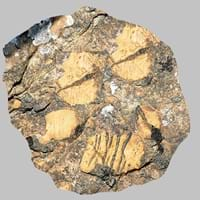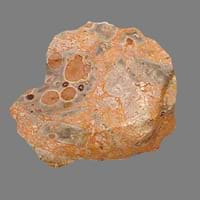Definition
Diamictite is a sedimentary rock that consists of non-sorted to poorly sorted terrigenous sediment containing particles that range in size from clay to boulders, suspended in a matrix of mudstone or sandstone
Felsite is a very fine grained volcanic rock that may or may not contain larger crystals and light colored rock that typically requires petrographic examination or chemical analysis for more precise definition
Origin
Southern Mongolia
Unknown
Discoverer
Unknown
Unknown
Etymology
From Greek dia through and meiktós or mixed
From English feldspar and -ite
Class
Sedimentary Rocks
Igneous Rocks
Sub-Class
Durable Rock, Soft Rock
Durable Rock, Medium Hardness Rock
Group
Not Applicable
Volcanic
Other Categories
Coarse Grained Rock, Opaque Rock
Fine Grained Rock, Opaque Rock
Texture
Clastic
Arborescent Patterned, Vitreous
Color
Brown, Buff
Black, Blue, Brown, Green, Orange, Red, Tan, Yellow
Durability
Durable
Durable
Appearance
Banded
Layered, Banded, Veined and Shiny
Interior Uses
Decorative Aggregates, Interior Decoration
Decorative Aggregates, Flooring, Interior Decoration
Exterior Uses
As Building Stone, Paving Stone
Paving Stone, Garden Decoration
Other Architectural Uses
Curbing
Curbing
Construction Industry
As Dimension Stone, Construction Aggregate, for Road Aggregate, Landscaping, Roadstone
Arrowheads, Cutting Tool, Knives, Scrapers, Spear Points
Medical Industry
Not Yet Used
Surgery
Antiquity Uses
Artifacts
Artifacts
Commercial Uses
Commemorative Tablets, Creating Artwork, Production of Lime
Mirror, Jewelry
Types
Bedded Diamictite and Laminated Diamictite
Not Available
Features
Host Rock for Lead, Is one of the oldest rock
Available in Lots of Colors and Patterns, Clasts are smooth to touch, Splintery, Very fine grained rock
Archaeological Significance
Monuments
Not Yet Used
Not Yet Used
Famous Monuments
Not Applicable
Not Applicable
Sculpture
Not Yet Used
Not Yet Used
Famous Sculptures
Not Applicable
Not Applicable
Figurines
Not Yet Used
Not Yet Used
Formation
Diamictite is unevenly sorted terrigenous, non-calcareous sedimentary rock which forms due to weathering of mudstone and sandstone.
Felsite is a fine-grained, hard rock which is a type of metasomatite, essentially altered basalt. It forms with or without crystallization, either below the surface as intrusive rocks or on the surface as extrusive rocks.
Mineral Content
Calcite, Clay, Feldspar, Micas, Quartz
Feldspar, Iron Oxides
Compound Content
Not Available
Aluminium Oxide, CaO, Iron(III) Oxide, FeO, Potassium Oxide, MgO, MnO, Sodium Oxide, Phosphorus Pentoxide, Silicon Dioxide, Titanium Dioxide
Types of Metamorphism
Not Applicable
Burial Metamorphism, Contact Metamorphism, Impact Metamorphism, Regional Metamorphism
Types of Weathering
Biological Weathering, Chemical Weathering
Biological Weathering, Chemical Weathering, Mechanical Weathering
Types of Erosion
Chemical Erosion, Coastal Erosion, Water Erosion
Chemical Erosion, Glacier Erosion, Water Erosion
Grain Size
Coarse Grained
Fine Grained
Fracture
Conchoidal to Uneven
Conchoidal
Streak
Light to dark brown
White
Porosity
Highly Porous
Very Less Porous
Luster
Grainy, Pearly and Vitreous
Vitreous
Compressive Strength
Not Available
Cleavage
Not Available
Non-Existent
Toughness
Not Available
Not Available
Specific Gravity
4.3-5.0
2.6-2.7
Transparency
Opaque
Translucent
Density
2.2-2.35 g/cm3
2.6 g/cm3
Resistance
Heat Resistant, Impact Resistant
Heat Resistant, Impact Resistant
Deposits in Eastern Continents
Asia
China, India, Kazakhstan, Mongolia, Russia
Afghanistan, Indonesia, Japan, Russia
Africa
Namibia, Nigeria, South Africa
Kenya
Europe
Austria, Denmark, Germany, Great Britain, Netherlands, Norway, Poland, Sweden, Switzerland, United Kingdom
Greece, Hungary, Iceland, Italy, Turkey
Others
Not Yet Found
Not Yet Found
Deposits in Western Continents
North America
Canada, USA
Canada, Mexico, USA
South America
Brazil, Venezuela
Argentina, Chile, Ecuador, Peru
Deposits in Oceania Continent
Australia
New South Wales, New Zealand
New Zealand
All about Diamictite and Felsite Properties
Know all about Diamictite and Felsite properties here. All properties of rocks are important as they define the type of rock and its application. Diamictite belongs to Sedimentary Rocks while Felsite belongs to Igneous Rocks.Texture of Diamictite is Clastic whereas that of Felsite is Arborescent Patterned, Vitreous. Diamictite appears Banded and Felsite appears Layered, Banded, Veined and Shiny. The luster of Diamictite is grainy, pearly and vitreous while that of Felsite is vitreous. Diamictite is available in brown, buff colors whereas Felsite is available in black, blue, brown, green, orange, red, tan, yellow colors. The commercial uses of Diamictite are commemorative tablets, creating artwork, production of lime and that of Felsite are mirror, jewelry.










